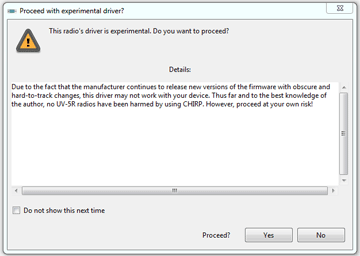

Here are some configures I would appreciated feedback on my interoperation of the FCC rules as I am relatively new to interpreting them.
#Chirp programming columns Patch
After some feedback on the mailing list, I've chosen to number the channels according to the FRS numbering, rather than try to preserve the obsolete numbering, and I've chosen to name the GMRS repeater channels with both the "" style numbering that's common in repeater naming and the "15R" name that makes it clear that it's receiving on channel You can find information about submitting a patch here: DevelopersProcess.

Revision dd3f5ade Added by Andrew Jorgensen 10 months ago. There are 22 FRS frequencies, all require narrow band and Since receiving NFM when configured for FM causes low volume issues or vice-versa seems it would be best to have two separate sets of these frequencies, if there is a truly cross-compatible set of frequencies here perhaps a 3 third merged list would be appropriate to allow users to easily select which they would prefer. If the duplex is set to split then the Offset field should contain the absolute transmit frequency to be used if the radio supports this capability.Added by A J over 2 years ago. If set to None then the transmit and receive frequencies are the same. This sets the duplex mode of the channel. The corresponding character is N for normal or R for reversed aka "inverted" polarity. The first character pertains to the transmit polarity and the second pertains to receive polarity.
#Chirp programming columns code
This sets the DTCS code to be used for receiver squelch if the radio supports this capability and Tone Mode is set to Cross see description of Cross Mode for more details. In Cross mode it has additional meanings see description of Cross Mode for more details. In Cross mode, it has additional meanings see description of Cross Mode for more details. The following explains what the options means. This sets the mode used to transmit or receive squelch tones or related selective calling technologies. The length and valid characters are defined by what the radio is capable of supporting. This is the alphanumeric label for the memory, as displayed on the front panel. If Duplex is set to None, then it is also the transmit frequency of the channel. This defines the receive frequency of the channel in Megahertz. The limits of what can be in this field are defined by your radio. This is the location or "channel number" of the memory. Also, enabling Smart Tone Modes in the same location can be rather helpful for reducing confusion. Users unfamiliar with programming radios are encouraged to enable Hide Unused Fields mode in the View menu. In most cases, the default value for a column can be used if you don't know what the meaning of the column is. This document is intended to help users understand the meaning of each column in the channel editor.


 0 kommentar(er)
0 kommentar(er)
